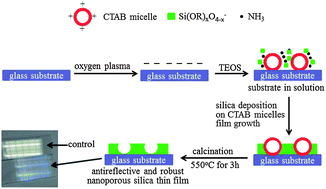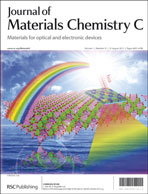A novel precursor-derived one-step growth (POG) approach has been developed to fabricate highly antireflective, mechanically robust and self-healing nanoporous silica thin films. The nanoporous silica thin films were uniform and smooth with low roughness. Their transmittance decreased with the increase of exposure time to wet air, but it could completely self-heal after exposure to dry air. The key to achieving the antireflective nanoporous silica thin films is to control the growth time, CTAB/TEOS ratio and reaction temperature in the Stöber solution. The maximum transmittance of coated substrates reached as high as 99.2%. The thin film coated glass substrates also exhibited excellent reduced reflection at high incident angles in addition to a significant reduction in broadband reflection. Meanwhile the thin films have excellent mechanical strength and stability (passed the 6H pencil hardness test, sand flow test and washability test). The current approach is facile, effective and versatile, and may open a new avenue to advanced multifunctional optical films of varied compositions and other 2D nanoarchitectures, and provide many new and exciting opportunities in the fabrication of functional devices for optics, electronics, optoelectronics, electrochemistry, molecule separation, and so on.

You have access to this article
 Please wait while we load your content...
Something went wrong. Try again?
Please wait while we load your content...
Something went wrong. Try again?


 Please wait while we load your content...
Please wait while we load your content...